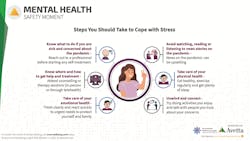Most often, stress has a negative connotation. We associate stress with headaches, sweating, rises in blood pressure and other physical symptoms.
In reality, however, stress serves to help and protect us. The stress response is part of our evolutionary biology since our earliest human ancestors depended on it for survival. When we face serious threats or danger, stress creates adrenaline and a boost of energy and gives us the extra brain power to focus on what’s needed.
The problem is that, in today’s environment, there are too many stressors. We’ve just been through a pandemic that caused us to miss a lot of events and stay home for longer than we’ve been used to. National and world events have only added to that stress.
The American Psychological Association regularly polls Americans about their stress levels. In March, more than 80% of respondents said the biggest stressors of their lives included all of these concerns: inflation, supply chain issues, global uncertainty and Ukraine. The report stated that while we are doing remarkably well in coping with these issues, we are reaching “unprecedented levels of stress.”
The report also notes that diminished social support during the pandemic made coping with stress much more difficult. It’s time we reverse these trends, and it starts with us as leaders. We don’t have to perpetuate negative and stressful environments any longer, especially in the workplace. There are changes you can make in your organization to reduce stress and improve mental and physical health for all. You can start by developing a new understanding of stress, creating a long-term strategy for your organization, and helping people feel connected and supported.
Change Your Outlook on Stress
In his seminar on building personal resilience against stress, Neil Shah, the chief de-stressing officer of The Stress Management Society and founder of International Wellbeing Insights, helps us understand stress in a few different ways. Stress can be represented as an equation: force divided by area equals pressure. That is, to reduce pressure (or stress), you must spread the weight over a larger surface or reduce the load.
Another way to view this explanation is to think of people as bridges: If there is a large load of heavy trucks piled in a single spot on the bridge, the bridge might collapse. However, if the trucks are spread out across the bridge, the bridge will stand.
The key is to find the balance between the amount of stress and a person’s ability to handle it—too little stress and people get bored and depressed; too much stress and people get burned out and breakable.
Make a Long-term Strategy
To make lasting changes in your organization, you need more than just “initiatives”; you need a long-term strategy. Shah compares organizational change to a GPS: In order to get anywhere, you need to know where you currently are and where you want to end up. Then you can see the path that will take you there.
You can evaluate where your organization stands in terms of mental health through interviews, surveys, focus groups and visits. The vision of where you want to be can be created through leadership visioning exercises and goal mapping. The steps to get there might include training, workshops and policy changes, to name a few.
It is worth noting that many employees would love to see more mental health benefits at work. A 2022 report by PeopleKeep shows that 63% of employees value mental health benefits (one of the most valued benefits), yet only 5% of employers offer such benefits. That leaves a lot of room for improvement. Consider adding mental health benefits for your workers, such as wellness programs, therapy and employee assistance programs.
Connect with and Support People
Finally, in the increasingly virtual world, we are losing our connection with each other. There are fewer opportunities for “water cooler conversations,” and people can lose interest in each other’s lives.
One way to combat this is to ask more questions about how people are doing—and not just the basic “How are you?” which merits the canned response, “I’m fine.” Shah encourages people, especially leaders, to always follow up with a second question, such as “How are you?” “What’s the latest with your life?” or “Are you sure you are ok?” To get genuine answers, you must also be honest about your life and cultivate an open, vulnerable dynamic.
It is also important to make sure people feel supported and have access to all the resources they need when dealing with stress or mental health challenges. Make the resources easy to find, and use signs and emails to communicate so everyone knows what is available.
No organization will function well when its workforce is stressed and burned out. If you want people to perform well and thrive at work while staying healthy physically, mentally and emotionally, it is worth taking steps to transform your organization. In your efforts to create a less stressful organization, realize that you don’t need to create huge programs—small steps matter. Start small, and you’ll find that those small steps can make a big difference. Use these insights and suggestions to get started to help put an end to the stressful work environment.
Richard Parke is a senior vice president for Supplier Services at Avetta

